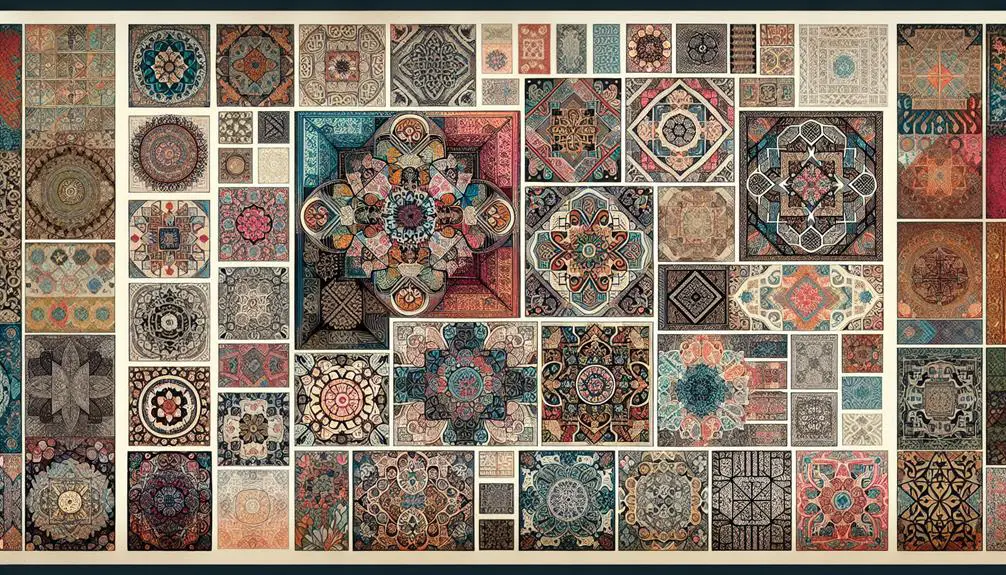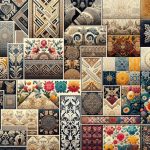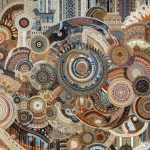You might not know that the earliest textile patterns were often imbued with symbolic meanings tied to the wearer's status or beliefs. As you delve into this captivating subject, you'll notice how societies from ancient Egypt to Renaissance Europe used textiles not just for practicality but as a canvas for artistic expression. The shift from handwoven fabrics to industrially produced textiles marks significant changes in design complexity and accessibility. What transformations did the Industrial Revolution bring, and how have modern technologies redefined textile patterns? Let's explore how each historical phase contributed uniquely to this constantly evolving art form.
Table of Contents
Key Takeaways
- Ancient textiles displayed intricate patterns with vibrant dyes and craftsmanship, serving as cultural artifacts.
- Renaissance innovations introduced ornate floral designs and geometric symmetry influenced by cultural exchanges.
- Colonial influences blended European designs with indigenous craft techniques, creating hybrid patterns.
- The Industrial Revolution democratized patterned textiles through mechanized looms and mass production.
- Modernist movements embraced simplicity and abstraction, while the digital age introduced customized, sustainable textile designs.
Ancient Textiles
Ancient textiles offer a captivating peek into early human artistry and technological innovation. To truly appreciate the complexity and skill involved, you must explore the intricacies of Egyptian weavings and Mesopotamian tapestries.
Egyptians were pioneers in textile creation, mastering the art of weaving linen from flax. Their expertise allowed them to produce fabrics that weren't only functional but also visually stunning. You can see their artistic prowess in the intricate patterns and designs, ranging from geometric shapes to elaborate depictions of gods and pharaohs.
Mesopotamian tapestries, on the other hand, showcase a different facet of ancient textile mastery. Renowned for their use of wool, Mesopotamian artisans created tapestries that were both durable and richly adorned. Their patterns often featured complex motifs, such as mythical creatures and religious symbols, reflecting the culture's deep spiritual and cosmological beliefs.
The combination of vibrant dyes and meticulous craftsmanship resulted in textiles that served as important cultural artifacts.
Medieval Patterns
During the medieval period, textile patterns became more intricate and symbolically rich, reflecting the era's evolving aesthetics and cultural narratives. You'll find that medieval tapestries and intricate weavings often depicted elaborate scenes from mythology, history, and daily life. Each thread and stitch carried significant cultural meanings, serving not just as decoration but as storytelling mediums.
When examining medieval embroidery, you'll notice detailed motifs that exhibit an extraordinary level of craftsmanship. Embroiderers used these motifs to convey themes of religious devotion, chivalric tales, and natural elements. The detailed motifs in garments, altar cloths, and wall hangings conveyed status and piety, elevating the textile to a form of high art.
You should appreciate how artisans of the time mastered techniques that allowed for the creation of these complex patterns. They employed an array of stitches and weaving methods to produce textures and images that weren't only visually stunning but also durable.
Renaissance Innovations
As you explore Renaissance textile innovations, you'll notice the emergence of ornate floral designs and geometric symmetry. These patterns reflect the era's fascination with harmony and nature.
Pay attention to how these elements transformed fabric aesthetics and set new standards in textile artistry.
Ornate Floral Designs
Renaissance innovations brought a dramatic transformation to textile patterns, with ornate floral designs becoming a hallmark of the era. You'll find that floral symbolism was pivotal, as each flower carried specific meanings, reflecting the culture and values of the time. These designs weren't just about beauty; they conveyed messages and emotions, adding depth to the textiles.
Mastering the textile production techniques of the Renaissance meant embracing intricate details. Craftsmen developed advanced weaving and dyeing methods to create vibrant, enduring patterns. The table below highlights key characteristics that set Renaissance floral designs apart:
| Characteristic | Description | Impact |
|---|---|---|
| Floral Symbolism | Each flower had a distinct meaning | Added layers of cultural significance |
| Advanced Weaving | More intricate techniques and materials | Enhanced pattern intricacy |
| Rich Color Palettes | Use of natural dyes, deep hues | Vibrant, long-lasting textiles |
| Ornate Detailing | Fine, elaborate patterns | Luxurious aesthetic |
| Cultural Reflection | Inspired by nature and humanism | Mirrored societal values |
To truly appreciate these textiles, you need to understand the synergy between symbolism and technique. The Renaissance floral designs weren't mere decorations; they were storytelling mediums, each petal and vine a tribute to the era's artistic and cultural renaissance.
Geometric Symmetry Flourishes
Embracing mathematical precision, artisans of the era introduced geometric symmetry to elevate textile patterns beyond mere decoration. You'll find that these Renaissance innovations weren't just about aesthetics; they embodied an intellectual pursuit of harmony and balance.
By incorporating geometric symmetry, craftsmen could create intricate, repeating motifs that left a lasting impact on the textile industry.
To truly appreciate this transformation, consider the following:
- Mathematical Influence: Artisans started using geometry to guide their designs, resulting in patterns that weren't only visually pleasing but also mathematically precise.
- Cultural Exchange: The Renaissance was a period of cultural exchange, and the introduction of geometric patterns in textiles was influenced by Islamic art, which had long embraced symmetry and repetitive designs.
- Contemporary Interpretations: Modern textile designers still draw inspiration from these historical patterns, blending them with new technologies to create innovative fabrics.
Colonial Influences
When you explore colonial influences on textile patterns, you'll notice a blend of European design adoption and indigenous craft techniques.
This period saw colonizers importing their styles while also adopting local methods and materials.
The result is a fascinating fusion that reflects both cultures.
European Design Adoption
As European powers expanded their empires, they began to integrate and adapt the detailed textile patterns from their colonies into their own designs. You can see how European influences reshaped traditional craftsmanship, creating a fusion of styles that still resonates today.
This cultural exchange wasn't just about aesthetics; it transformed the textile industry fundamentally. To truly master the subject, consider these aspects:
- Pattern Integration: European designers started to incorporate motifs and techniques from Asian and African textiles. They blended these with their own styles, resulting in unique, hybrid patterns that became highly sought after.
- Technological Advancements: The use of European machinery and processes allowed for more precise and consistent reproduction of these detailed designs. This technological edge made it possible to mass-produce patterns that were once laboriously handcrafted.
- Cultural Symbolism: Many of the adopted designs carried deep cultural significance in their countries of origin. European adaptations often simplified these motifs, focusing on aesthetic appeal while sometimes stripping away their original meanings.
Understanding how these factors played a role in European design adoption will give you a thorough grasp of how colonial influences have shaped modern textile patterns.
Indigenous Craft Techniques
Many indigenous craft techniques underwent significant changes due to colonial influences, reshaping their traditional methods and aesthetics. You've likely seen how colonial powers, through trade and force, introduced new materials and tools to indigenous artisans. This interaction not only diversified the textile patterns but also altered the resources used in creating them. Indigenous weavers began incorporating imported threads and dyes, which sometimes replaced or supplemented natural materials like cotton, wool, and plant-based dyes.
The introduction of new weaving tools and techniques allowed for more intricate weaving techniques, which became a hallmark of these evolved textile patterns. Colonial influences often brought about a fusion of styles, blending indigenous motifs with European designs, leading to an extraordinary hybrid art form.
To better understand the changes, let's look at a comparison:
| Feature | Pre-Colonial Era | Post-Colonial Era |
|---|---|---|
| Materials | Natural materials only | Natural and imported materials |
| Tools | Handmade, traditional tools | Introduced mechanical tools |
| Designs | Indigenous motifs | Fusion of indigenous and European motifs |
| Techniques | Basic weaving techniques | Intricate weaving techniques |
You see, colonial influences didn't just alter the physicality of the textiles; they transformed the cultural significance and artistic expression embedded within every weave and dye. Understanding these changes can deepen your appreciation for the resilience and adaptability of indigenous artisans.
Industrial Revolution
The Industrial Revolution transformed textile patterns by introducing mechanized production techniques. This era marked a significant shift from handcrafted to factory production, driven by technological advancements. You saw the emergence of power looms and spinning jennies, which revolutionized the weaving process. These innovations enabled mass production and mechanized weaving, making textile patterns more uniform and intricate.
Factory production allowed for rapid replication of designs, something previously unimaginable. You could now produce textiles at a scale and speed that artisans couldn't match. This democratized access to patterned textiles, bringing them into everyday life. The variety of patterns expanded as designers experimented with new capabilities.
Here's how the Industrial Revolution impacted textile patterns:
- Consistency and Precision: Mechanized looms guaranteed that patterns were replicated with exact precision, eliminating human error.
- Increased Variety: With faster production speeds, designers had more freedom to create and test new patterns, diversifying available styles.
- Affordability: Mass production drastically reduced costs, making patterned textiles accessible to a broader audience.
Modernist Movements
Modernist movements in textile design embraced simplicity, abstraction, and a break from traditional patterns. You'll find that these movements revolutionized the way textiles were perceived and created.
Bauhaus aesthetics, for instance, introduced a functional yet visually compelling approach. By emphasizing geometric forms and primary colors, Bauhaus designers like Anni Albers transformed textiles into pure visual art. You can see how this shift allowed for the creation of versatile, flexible designs that could adapt to various uses.
Abstract expressionism also played a pivotal role. Unlike the precise geometry of Bauhaus, abstract expressionism focused on spontaneity and emotional intensity. Textiles inspired by this movement often feature bold, sweeping strokes and a vivid palette, offering a dynamic contrast to the structured patterns of the past.
When you study these designs, you'll notice a liberation from symmetry and repetition, encouraging a more personal and interpretative engagement with the fabric.
Mastering these modernist principles will elevate your understanding of textile design's evolution. By appreciating the Bauhaus's disciplined creativity and abstract expressionism's emotive power, you'll gain insights into how modernist movements reshaped the textile landscape, setting the stage for future innovations.
Digital Age Designs
In the digital age, textile design has embraced advanced technologies to create intricate, customizable patterns with unprecedented precision. You're witnessing a revolution, where digital printing and innovative techniques are pushing the boundaries of what's achievable.
Unlike traditional methods, digital printing allows for limitless creativity and detail, enabling designers to produce complex designs without the constraints of manual labor.
Consider these advantages:
- Customization: Digital printing lets you tailor patterns to specific needs, offering unparalleled flexibility in design. You can experiment with colors, shapes, and textures to create unique pieces that stand out.
- Efficiency: Traditional textile production can be time-consuming and labor-intensive. Digital techniques streamline the process, reducing waste and speeding up production times. This efficiency aligns perfectly with the principles of sustainable fashion, where minimizing resource use and waste is essential.
- Ethical Production: Digital printing supports more ethical production practices. By reducing the need for harmful dyes and chemicals, it lessens the environmental impact, promoting a more sustainable approach to fashion.
As you explore the world of digital age designs, you'll find that the marriage of technology and artistry opens up a domain of endless possibilities, all while prioritizing sustainability and ethical practices.
Frequently Asked Questions
How Have Climate Changes Impacted Textile Pattern Development Over Centuries?
You've witnessed how climate influences have driven historical adaptations in textile patterns. Climate changes dictated material availability and necessitated design innovations, ensuring textiles remained functional and reflective of prevailing environmental conditions over the centuries.
What Role Do Textile Patterns Play in Different Cultural Rituals?
You'll find textile patterns hold cultural significance in ritual practices. They reflect the historical evolution of cultural traditions, symbolizing beliefs and values. Patterns act as visual narratives, enhancing the depth and meaning of these rituals.
How Do Natural Dyes Influence the Longevity of Textile Patterns?
Natural dyes can make textile patterns last an eternity, enhancing their sustainability. You'll notice unmatched color vibrancy that synthetic dyes can't replicate. Their eco-friendly nature guarantees your textiles not only endure but also stay stunningly vivid.
What Are the Economic Implications of Evolving Textile Patterns in Global Markets?
You'll see that evolving textile patterns shape global trade by influencing market trends. Staying ahead with innovative designs can boost your competitive edge, driving demand and economic growth in diverse markets worldwide.
How Have Symbolic Meanings in Textile Patterns Evolved Across Different Eras?
You'll find that symbolic interpretations in textile patterns weave a tapestry of historical significance, shifting like sands through time. Each era imbues patterns with unique meanings, reflecting cultural values and societal changes, enriching your understanding.
- How Does Ring Spun Cotton Affect Garment Fit and Shape Retention? - August 13, 2024
- What Are the Challenges in Producing Ring Spun Cotton? - August 13, 2024
- Is Ring Spun Cotton Suitable for Plus-Size Clothing? - August 13, 2024




